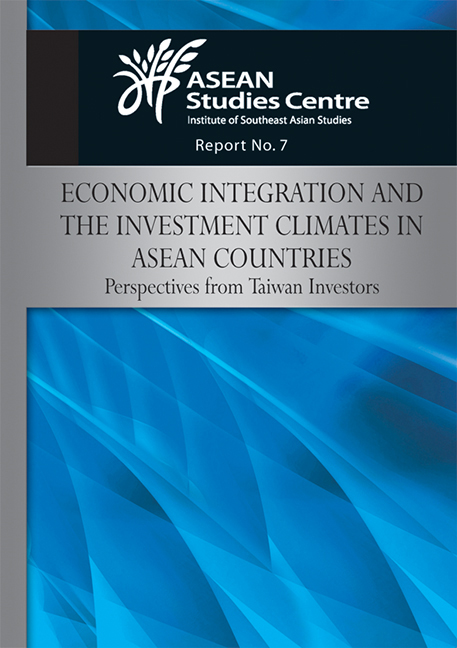 Economic Integration and the Investment Climates in ASEAN Countries
Economic Integration and the Investment Climates in ASEAN Countries from II - Background Papers
Published online by Cambridge University Press: 21 October 2015
Introduction
Taiwanese transnational capital emerged in the mid-1980s, and its importance is now widely recognized by Taiwanese scholars in various disciplines. There has been an increasing interest to investigate the nature of this newly emerging transnational capital, which is considered to be different from the Western or Japanese ones. Studies of Taiwanese businesses (Taishang) in Southeast Asia have concentrated on the domains of overseas investment patterns (Chen 1994, 1998; Lin 2001), industrial relations (Kung 2002; Wang 2002), and ethnic relations and overseas Chinese networks (Hsiao and Kung 1998; Tseng 1999). Some scholars have noted that, to Taishang, Southeast Asia is not only a geographical area, but also a cultural entity, and thus their investment behaviour as a whole is embedded in the social contexts of the region. As latecomers to transnational capital in Southeast Asia, the Taishang demonstrates some distinguishing features.
This paper argues that the Taishang phenomenon in Southeast Asia should be understood first in terms of its capital formation and special characteristics, and second in terms of the influences of the political economy of the host countries. The paper tackles the issue of how the Taishang have globalized their capital and business strategies to maintain their competitiveness in the world economy. It also explains how the Taishang have reorganized their industrial production networks and how they manage labour relations in Southeast Asia.
To save this book to your Kindle, first ensure [email protected] is added to your Approved Personal Document E-mail List under your Personal Document Settings on the Manage Your Content and Devices page of your Amazon account. Then enter the ‘name’ part of your Kindle email address below. Find out more about saving to your Kindle.
Note you can select to save to either the @free.kindle.com or @kindle.com variations. ‘@free.kindle.com’ emails are free but can only be saved to your device when it is connected to wi-fi. ‘@kindle.com’ emails can be delivered even when you are not connected to wi-fi, but note that service fees apply.
Find out more about the Kindle Personal Document Service.
To save content items to your account, please confirm that you agree to abide by our usage policies. If this is the first time you use this feature, you will be asked to authorise Cambridge Core to connect with your account. Find out more about saving content to Dropbox.
To save content items to your account, please confirm that you agree to abide by our usage policies. If this is the first time you use this feature, you will be asked to authorise Cambridge Core to connect with your account. Find out more about saving content to Google Drive.